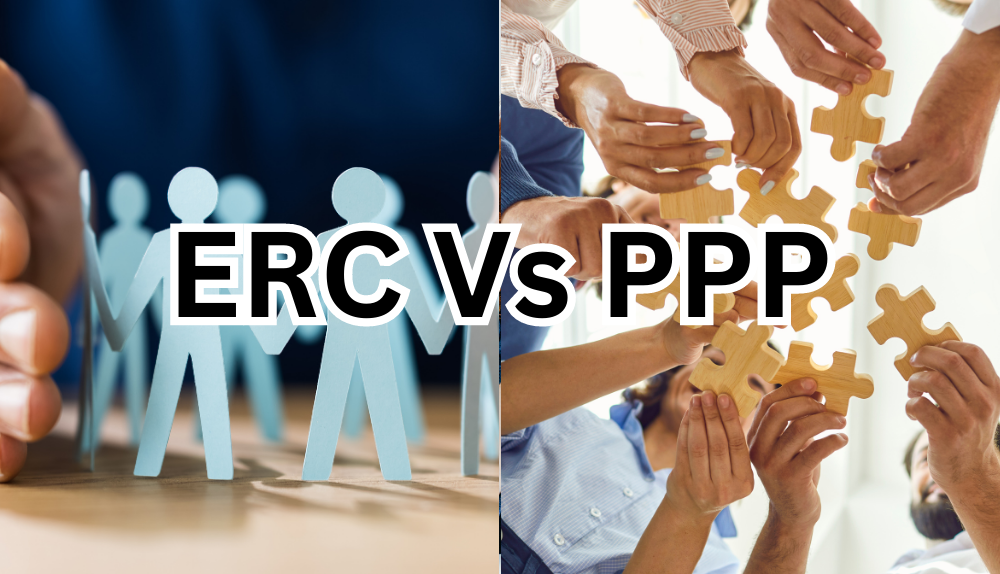When the COVID-19 pandemic caused widespread business shutdowns and job losses, policymakers created two major programs to aid small employers and incentivize job retention: the Paycheck Protection Program (PPP) and Employee Retention Credit (ERC). PPP provided forgivable loans to cover payroll, rent, mortgage interest, and utilities. ERC granted tax credits for retaining employees during the crisis. In this article we will delve into the differences between ERC vs PPP and how this information can help you.
Though developed with a similar goal of supporting employment, PPP and ERC represented very different approaches in how funds were distributed and could be used. PPP loans were administered through banks and the Small Business Administration to businesses, while ERC tax credits were claimed through quarterly tax filings. PPP loans could cover a wide range of expenses, but ERC credits were specifically aimed at wage costs.
PPP distributed over $670 billion in funds, while ERC provided up to $33 billion in tax credits. There were challenges in effectively implementing each program and ensuring equitable access for small and minority-owned businesses. However, for those able to take advantage of the programs, PPP loans and ERC credits proved crucial in keeping employees on the payroll, meeting financial obligations, and sustaining business operations during an economic shutdown.
Despite their differences, PPP and ERC shared the key goal of job retention and represented two of the largest components of COVID-19 relief efforts. There are also debates about extending or redesigning each program to continue supporting employers and employees. However, PPP ended in May 2021 while ERC remains available, creating uncertainty over their long-term impact and legacy.
The Paycheck Protection Program (PPP)
The Paycheck Protection Program (PPP) provided $670 billion in forgivable loans to small businesses and non-profit organizations. Established as part of the CARES Act, PPP aimed to incentivize employers to retain employees on the payroll by covering essential business expenses like payroll, rent, mortgage interest, and utilities. Loans of up to $10 million were available for businesses with under 500 employees, as well as some larger businesses.
PPP loans were administered through a partnership between the Small Business Administration (SBA) and over 5,000 private banks and credit unions. Businesses applied for the program through an SBA-approved lender, submitting information on payroll costs, number of employees, and other expenses. Loans would be forgiven if at least 60% was used for payroll, with the remainder covering authorized expenses and being repaid over two years at a 1% interest rate.
The program generated significant interest but also challenges in implementing and distributing funds effectively. There were issues with complex application processes, limited lender participation, and a lack of guidance leading to confusion and delays. Some critics argue PPP prioritized big businesses and did not do enough to reach minority and women-owned small businesses. However, for recipients, PPP loans proved crucial in retaining jobs, meeting financial obligations, and surviving an economic crisis.
By June 2020, PPP approved over 5 million loans worth $521 billion. The Biden Administration reopened the program, allowing more businesses to apply and increasing funding to $284 billion. Still, PPP ended in May 2021 without being extended, leaving its long-term impact uncertain. There are also debates around redesigning PPP, creating similar programs, or providing additional broad-based aid.
PPP aimed to strike a balance between targeted, needs-based relief and broad support for small businesses and employment. Though an imperfect program, it represents an important case study in crafting and implementing policy at scale during an emergency. By understanding PPP’s key features, challenges, and legacy, policymakers can improve future response efforts and better support economic recovery.
The Employee Retention Credit (ERC)
The Employee Retention Credit (ERC) provided up to $33 billion in tax credits for retaining employees during the COVID-19 crisis. Established as part of the CARES Act, ERC aimed to incentivize business continuity by offsetting wage costs for employers whose operations were fully or partially suspended due to government shutdown orders. Credits covered 50% of qualified wages paid, up to $10,000 per employee.
ERC tax credits were claimed through adjustments to quarterly federal tax payments. Eligible employers calculate the credit amount based on wages paid to retained employees and subtract that from total quarterly tax liability. Any excess credit is refunded. ERC primarily targets businesses with suspended operations, though some partially suspended businesses and employers of employees unable to work due to health issues also qualified.
ERC has faced less scrutiny and debate than PPP but also challenges in implementation and equitable distribution of funds. The IRS issued multiple sets of guidelines to clarify eligibility, creating confusion among some businesses. There were also concerns ERC did not do enough to reach very small employers or those without significant tax liability. However, for recipients, ERC proved crucial in covering wage and employment costs during shutdowns.
By Q4 2020, the IRS approved over 225,000 ERC claims representing $27.5 billion in credits. The Biden Administration expanded ERC eligibility and increased the credit amount, approving an additional $20 billion. Still, ERC remains available until the end of 2021, creating uncertainty if additional funding will be provided or if a similar program will replace it.
Like PPP, ERC aimed to strike a balance between targeted support and broad relief. ERC focused specifically on offsetting wage costs for suspended businesses, while PPP provided loans for various essential expenses with more flexibility. Though developed separately, ERC and PPP shared the overarching goal of job retention and represented two of the largest components of the CARES Act. An understanding of key differences helps in developing equitable and effective policies to support economic recovery.
ERC vs PPP
The Employee Retention Credit (ERC) and Paycheck Protection Program (PPP) were two of the largest components of the CARES Act, providing over $700 billion in combined aid. Though developed separately to support job retention, ERC and PPP represented very different approaches in distribution and permitted use of funds.
ERC granted tax credits for retaining employees during government-ordered closures. Credits covered 50% of qualified wages, up to $10,000 per employee, and were claimed through quarterly tax filings. ERC primarily targeted businesses with suspended operations, though some partially suspended businesses also qualified. Funds could only be used for payroll costs.
In contrast, PPP provided forgivable loans for a wider range of expenses including payroll, rent, mortgage interest, utilities, and more. Loans were distributed through banks and the SBA to small businesses and non-profit organizations. Loans of up to $10 million were available, and at least 60% was required for payroll, with the remainder covering authorized costs. Funds could be used with more flexibility than ERC credits, though also came with more conditions for loan forgiveness.
There were significant challenges in implementing both programs, including complex application processes, limited participation, confusion over guidelines, and lack of outreach to minority groups. However, for recipients, ERC and PPP proved crucial in covering costs, retaining employees, and surviving financial hardship. Debates also surround extending or redesigning each program to continue supporting employers and employees.
ERC and PPP aimed to strike a balance between targeted, needs-based aid and broad support for businesses and jobs. ERC focused specifically on payroll costs during suspended operations, while PPP provided flexible funding for essential expenses. Though developed separately, the programs shared this overarching goal and represented broad-based relief efforts amid an economic crisis.
Pros of ERC Vs PPP
Despite their differences, ERC and PPP shared important benefits in providing aid to businesses, employees, and economic recovery. Some key advantages of each program include:
ERC pros:
• Targeted support for payroll costs. ERC specifically targeted wage expenses, ensuring funds covered this critical business cost during suspended operations. This targeted approach aimed to minimize the misuse of resources while maximizing impact.
• Offset financial hardship. For recipients, ERC credits covered a major expense, reducing losses and enabling business continuity. This provided relief for employers still unable to operate fully due to closures.
• Flexible and gradual. ERC credits were claimed through quarterly tax filings, allowing flexible, gradual adjustments to financial hardship. This enabled the gradual reopening or scaling up of operations based on health guidelines and customer demand.
PPP pros:
• Broad support for essential costs. PPP loans could cover a wide range of critical expenses including rent, utilities, and more in addition to payroll. This flexibility enabled businesses to keep the lights on during shutdowns while also maintaining employment.
• Prevent job loss. By supporting essential business costs, PPP aimed to prevent mass job losses and enable quick rehiring once operations resumed. This could minimize the economic scarring effects of large-scale unemployment during a crisis.
• Gradual reopening. Like ERC, PPP’s flexible funding and gradual loan forgiveness process allowed for scaling operations up or down based on circumstances. This could support a soft landing as businesses found their footing after reopening.
• prevent bankruptcy. For some businesses, PPP loans prevented bankruptcy by covering costs they otherwise could not meet. This helped sustain economic actors and limit the damage of widespread business closures during the pandemic.
• Relieve financial pressure. PPP provided grants that did not need to be repaid, relieving the financial pressure of debt or more stringent loan terms. This granted relief through resources rather than loans, supporting cash flow and operations.
PPP and ERC each provided targeted benefits, with pros and cons in implementing policy at scale. Still, for recipients, the support afforded by these programs proved crucial in navigating the economic crisis. An understanding of key advantages supports crafting aid that achieves both needs-based and broadly impactful relief.
Conclusion
The Employee Retention Credit (ERC) and Paycheck Protection Program (PPP) represented distinct approaches to supporting job retention and economic continuity amid the COVID-19 crisis. Established through the CARES Act, ERC provided tax credits for retaining employees during government-ordered closures, while PPP offered forgivable loans for essential business expenses. Though developed separately, the programs shared the overarching goal of employer and employment support.
There were significant challenges in implementing PPP and ERC, including complex application processes, confusion over guidelines, limited participation, and lack of outreach to minority groups. However, for recipients, the aid afforded by these programs proved crucial in covering costs, paying employees, and surviving financial hardship. Debates also surround extending or redesigning each program to sustain support as the economic fallout of the pandemic continues.
PPP took a broader approach, covering payroll as well as rent, utilities, and other critical expenses with more flexibility. ERC targeted payroll costs specifically, aiming to minimize misuse of funds while maximizing impact. There are arguments for and against each approach, as well as for pairing targeted and flexible aid. A balanced, tailored response to the crisis is key but complex to achieve in practice.
PPP and ERC represent case studies in implementing large relief efforts at scale during an emergency. By examining differences in distribution, eligible uses of funds, challenges, and impact, policymakers can improve future policy solutions and support economic recovery with more effectiveness and equity. They also provide important lessons on crafting aid that balances needs-based support with broad relief.


